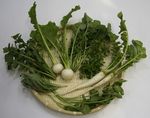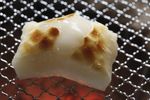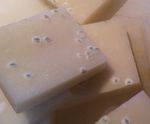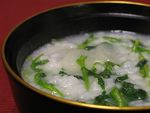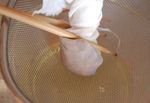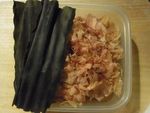seri - A Taste of Culture
←
→
Page content transcription
If your browser does not render page correctly, please read the page content below
Starting the New Year in Health
七草粥
Nanakusa-Gayu
Rice Porridge with 7 Spring Herbs
More than a thousand years ago, the Japanese spoke of watari-dori ("migrating
birds") coming from the Asian mainland in wintertime bringing with them unwanted
viruses – early evidence of avian flu epidemics! Eating nutritious nana (seven) kusa
(grasses) gayu (porridge) on the 7th day of the New Year was believed to strengthen
resistance to infection and colds. Indeed the seven grasses, or herbs, traditionally
cooked into rice gruel are vitamin and mineral rich leafy herbs and flowering greens.
The classic Japanese spring herbs haru no nana kusa are (left to right):
芹 seri
なずな nazuna
御形 gogyō
はこべら hakobera
仏の座 hotoké no za
すずな suzuna (turnip)
すずしろ suzushiro (daikon)
For those who like to make nana kusa-gayu in their
own kitchen, follow the recipe on the next page.
© Copyright 2020. All rights reserved by Elizabeth Andoh
1Adapted by the author from WASHOKU: Recipes from the Japanese Home Kitchen Ten Speed Press 2005
Rice Porridge with Seven Herbs Nana Kusa-Gayu 七草粥
Technically speaking, the word okayu connotes porridge made from raw rice cooked with
about three times the amount of water normally used to cook plain rice. Ozosui is the correct
term for cooked rice that is rinsed and then simmered in a flavored broth. This recipe, like
most homemaker versions of okayu uses leftover rice... and after the New Year celebrations,
leftover omochi (pounded rice taffy).
By the way, any blue-colored mold that may appear on
your rice taffy is related to penicillin (indeed the molds
were cultivated and used centuries ago in Japan to limit
infection in open wounds!).
Unless you have allergies that counter-indicate
consumption of related antibiotics, the moldy omochi
can be used as is... for a boost to fighting off infections.
Serves 4.
2 cups cooked rice (white, brown or mixed grains; leftovers are perfect)
4 cups Basic Sea Stock (Dashi, see below) and/or water or other broth
1/4 teaspoon salt (optional)
4 pieces of square omochi (rice taffy, grilled until puffy)
Tops from turnips, radishes, or other dark, leafy greens such as kale or watercress
This porridge can be as thick as oatmeal, or as thin as a pureed soup. If you like your
porridge stick-to-your-ribs thick and creamy, place 2 cups cooked rice in a 2-quart pot and
add 2 cups dashi sea stock or water or broth. If you prefer a thinner, rice gruel, rinse your
cooked rice (place rice in a fine mesh strainer and shower with cold water) BEFORE adding it
to the pot. Stir with a wooden spoon to break up any clumps of rice.
Cook over low heat, stirring frequently, until the grains of rice swell and begin to loose their
shape, about 5 minutes. Add 1 and 1/2 cups more stock or water; stir to incorporate. Add 4
pieces omochi rice taffy and continue to simmer several minutes over very low heat until the
rice taffy become soft and stretchy. Season the soup with a scant 1/4 teaspoon salt if you
wish, and continue to cook, stirring occasionally.
Tops from turnips, radishes, or other dark, leafy greens such as kale or watercress will taste
similar to the Japanese nana kusa greens and have a similar nutritional profile. These greens
can be a bit tough and fibrous, and the leaves much larger, than their Japanese counterparts.
You may want to briefly wilt, blanch or parboil your greens in boiling water first, then drain and
chop them coarsely before adding to your porridge. Stir to distribute, cook for one minute, and
taste. Adjust with a pinch more salt, if wanted. Serve piping hot in individual deep bowls. Eat
with a spoon and/or chopsticks.
© Copyright 2020. All rights reserved by Elizabeth Andoh
2Adapted by the author from WASHOKU: Recipes from the Japanese Home Kitchen Ten Speed Press 2005
Basic Sea Stock Dashi
出汁
Makes about 1 quart.
1 generous quart cold water; use filtered or bottled water for best results
2 x 4-inch (about 20 square cm) kombu (kelp)
2, 5-gram packets or 1/2 cup loosely packed katsuo bushi (dried bonito flakes)
Soak kombu in a pot with the water for 10 to 15 minutes before placing the pot over
medium-high heat. Remove the pot from the burner as soon as small bubbles begin
to rise and a few of them break at the rim of the pot. Add the fish flakes, scattering
them across the surface of the broth. The fish flakes at the top of a freshly opened
bag might take 5 or 6 minutes to begin to sink, while the powdery bits that settle at
the bottom of the package could sink almost immediately. To keep the stock from
tasting “fishy” it is best to strain the broth through a cloth or paper-lined colander
within 3 or 4 minutes of adding the flakes, even if the flakes have not sunk.
Dashi looses its delicate aroma and subtle flavors when frozen, so it is best to make
it fresh when you need it. Any unused dashi will keep well in a lidded glass jar for 3 to
4 days in the refrigerator. Depending on the type, and quality of kombu used, a
sediment sometimes forms at the bottom of the jar – it alone, is not cause for concern.
Signs of spoilage include a sweet, rather than smoky, smell, a film forming on the
surface or around the edges of your container, or stickiness when pouring.
© Copyright 2020. All rights reserved by Elizabeth Andoh
3You can also read



